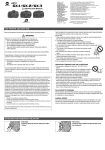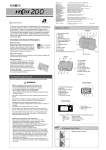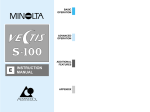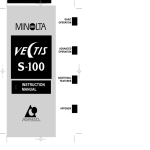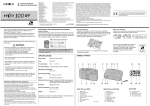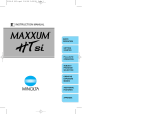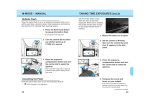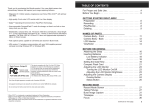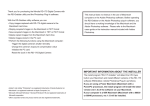Download Konica Minolta 30 Digital Camera User Manual
Transcript
E INSTRUCTION MANUAL Thank you for purchasing the Minolta Vectis 30. The Vectis 30 is an easy to operate lens shutter camera from Minolta’s new line of Advanced Photo System™ cameras. Your camera features drop-in loading, a 30 - 90mm zoom lens, and splashproof construction. In addition to providing built-in protection for the camera’s optics, the Vectis 30’s front cover provides a sophisticated appearance suitable for any occasion. This manual is designed to help you understand the operation of your camera and its functions. Please familiarize yourself with the names of the controls and their locations on the camera, then read this manual thoroughly. New print formats… Classic C print, wider H print, and panorama P print formats are available with Advanced Photo System cameras. * Advanced Photo System™ is a trademark of the five system developing companies. Advantages of the Advanced Photo System New processing… Easier to load… In addition to returning your prints in the format you selected, certified photofinishers will return your Advanced Photo System film in its original cassette with an index print. To order reprints, simply choose the images you want from the index print. No more searching through negatives to find the right frame. Advanced Photo System cameras use the new IX240 type film. This new film features drop-in-loading to make loading your camera simple, the first time, every time. Indicators on the cassette tell you and your camera if the film is unexposed, partially exposed, exposed, or processed. 1 TABLE OF CONTENTS FOR PROPER AND SAFE USE................4 NAMES OF PARTS..................................12 QUICK OPERATION................................16 GETTING STARTED Attaching the Strap ...................................19 Installing the Battery .................................20 Checking the Battery Power.....................21 BASIC OPERATION Loading Film .............................................23 Full-Auto Operation...................................27 For Closer Subjects ..................................30 Special Focusing Situations .....................32 Focus Hold................................................34 Rewinding the Film ...................................36 USING THE BUILT-IN FLASH Flash Lamp / Flash Range ........................40 Selecting the Flash Mode .........................41 Red-eye Reduction...................................42 Manual-fill Flash........................................43 Flash Cancel.............................................44 2 SUBJECT PROGRAM SELECTION Close-up Mode .........................................46 Portrait Mode ............................................48 Night Portrait Mode...................................50 Landscape / Night View Mode ..................52 APPENDIX Lab Services .............................................72 Caring For Your Camera ..........................74 Technical Details ......................................76 ADDITIONAL FEATURES Date Imprinting .........................................54 Title Imprinting ..........................................58 Self-timer...................................................64 Continuous-drive mode ............................66 Remote control (optional) .........................67 3 FOR PROPER AND SAFE USE STANDARD SYMBOLS SAFETY CAUTIONS Various symbols are used in the instruction manual to promote proper and safe use of this product. Read and understand each caution thoroughly before reading the instruction manual. Read and understand all cautions and warnings before using this product. WARNING Do not touch the flashtube during operation, it may become hot when the flash fires. EXAMPLES The outer triangle is for warning. The symbol inside illustrates what is being warned against. The example at left means beware of extreme heat. The circle with a diagonal slash is for prohibition (don’t do). The symbol inside illustrates what act is prohibited. The example at left means do not disassemble. 4 Do not look directly at the sun through the viewfinder. Do not subject the camera to direct sunlight. Fire may occur if the sunlight focuses at one point. Batteries may explode due to improper use. Read and follow all warnings supplied with the batteries. • Do not install the polarity (+/-) reversed. • Do not use batteries with visible damage. • Do not recharge, short, disassemble, or subject to high temperatures. 5 FOR PROPER AND SAFE USE CONT. WARNING Observe the following warnings when using this product near young children or persons who may have difficulty perceiving the potential danger associated with these products. If caution is not used, the following accidents or others may occur: • Flash fired near the eyes. • Strap wound around the neck. Keep batteries and other things that could be swallowed away from young children. Contact a doctor immediately if an object is swallowed. 6 CAUTION Do not fire the flash near the eyes of people or animals, especially infants and young children. Do not fire the flash if your subject is closer than the minimum flash distance stated in the manual. If the camera is dropped or subjected to an impact in which the interior is exposed, immediately remove the batteries and discontinue use. Do not disassemble. Take your camera to a Minolta Service Facility when repairs are required. Electric shock may occur if a high voltage circuit inside the camera is touched. 7 SPLASHPROOF NOTES THIS CAMERA IS SPLASHPROOF AND CAN BE USED IN LIGHT RAIN OR SNOW. • Do not place the camera under running water or immerse. Please Note: 1. When using the camera outdoors in heavy rain, keep the camera protected from the rain. 2. The interior of the camera is not moisture resistant. - Dry the camera before opening the film or battery chambers. - When inserting or removing film or batteries, keep your hands dry. 3. Do not load film or replace batteries in places where water, blowing sand, or dust can enter the camera. 4. This camera is not sandproof, do not place the camera directly on the ground. 8 5. Remove moisture from the camera, especially salt water and spilled liquids containing sugar. 6. If the rubber seals appear cracked or damaged, contact the nearest Minolta Service Facility to have them replaced. 7. Close the film and battery chamber covers tightly. Clean the rubber seals before closing covers. 8. The IR Remote Control RC-3 is not splashproof. 9 OPERATING CONDITIONS OPERATING TEMPERATURE AND CONDITIONS FILM CASSETTE WARNING • This camera is designed for use from -10 to 40°C (14 to 104°F). • Never leave your camera where it may be subjected to extreme temperatures such as in the glove compartment of a car. • At colder temperatures, the data panel response time will be slow. At higher temperatures, the display will temporarily darken, but will restore when the temperature normalizes. • Never subject the camera to extreme humidity. • To prevent condensation from forming, place the camera in a sealed plastic bag when bringing it from the cold exterior into a warm building. Allow it to come to room temperature before removing it from the bag. • When photographing in cold weather, we recommend that you keep the camera and spare batteries inside your coat to keep them warm when you are not shooting. Cold batteries will regain some of their charge when they warm up. The film used in Advanced Photo System cameras stores some data magnetically. Do not place the cartridge on or near anything that creates a magnetic field, such as a television or stereo speakers. 10 CAMERA ERROR If all the indicators in the data panel blink, or the data panel is blank and the camera will not function with fresh batteries, remove and reinsert the batteries. If normal operation does not resume, or the camera malfunctions repeatedly, contact an authorized Minolta Service Facility. 11 NAMES OF PARTS Camera Body For information on specific parts, refer to the page numbers shown in parenthesis. Shutter-release Autofocus window* button Viewfinder window* Viewfinder* Format-selector switch Zoom lever Front cover Flash (p. 39) Flash-mode button Battery cover Remote-control receiver (p. 67) Self-timer / Remotecontrol button Manual-rewind button (p. 37) Film-chamber release (p. 24) Tripod socket Lens* Strap eyelet Subject-program-select button (p. 45) Metering window* 12 * - Do not touch Film chamber 13 NAMES OF PARTS CONT. Data Panel Viewfinder Portrait mode indicator (p. 48) Title mark Close-up mode indicator (p. 46) Title button Select button Adjust button Date button Flash mode indicator (p. 41) Continuous-drive indicator (p. 66) Self-timer indicator (p. 64) Night portrait mode indicator (p. 50) Close-framing guides (p. 31) Landscape / Night-view mode indicator (p. 52) Title / Date-time / Focal length / film speed indicator Subject program pointer Film speed mark Focal length mark Frame counter Film transport signals Battery-condition indicator (p. 21) Film cartridge mark Remote-control indicator (p. 67) Focus lamp (green) lamp on focus OK slow blinking special focus situation see p. 32 fast blinking too close Flash lamp (orange) Focus frame on flash charged slow blinking use flash or tripod fast blinking flash charging • Only the necessary indicators will appear in the data panel. 14 15 QUICK OPERATION 2 1 1. Insert the battery. (p. 20) 2. Open the front cover, then insert the film. (p. 24) 3. Select the print format. (p. 27) 4. Frame the subject as desired. (p. 28) W 5. Center your subject in the focus frame. (p. 28) 6. Press the shutterrelease button all-theway down to take the picture. (p. 29) T 16 17 ATTACHING THE STRAP Attach the strap as shown. GETTING STARTED 18 19 INSTALLING THE BATTERY Your camera uses one 3-volt CR-2 battery to supply power for all camera operations. CHECKING THE BATTERY POWER Each time the main switch is turned on, a symbol will appear in the data panel to indicate the power status of the batteries. • Remove dirt and moisture from the camera and battery before opening the battery chamber cover. 1. Using a coin, open the battery chamber door as shown. 2. Insert the battery into the chamber as indicated by the + and - marks. 3. Snap the battery chamber door shut. • After installing a new battery, will blink in the data panel. Reset the date and time. (see p. 55) 20 Power is sufficient for all camera operations. Power is sufficient, but the battery will have to be replaced soon. Replace the battery. The shutter will lock until the battery is replaced. • If no display appears, replace the battery or check that it is inserted correctly. • To save power, your camera will shut down and retract the lens if it is not operated for more than three minutes. To restore power, close and open the front cover. • Do not obstruct the lens while it is retracting. 21 LOADING FILM Your camera uses IX240 type film designed for use in Advanced Photo System cameras. BASIC OPERATION • Your camera’s automatic transport system loads the film, sets the film speed, and advances the film after each exposure. • The film chamber will not open unless it is empty, or the film is completely rewound. • DEP, Double Exposure Prevention, prevents the camera from accepting exposed film. Visual Exposure Indicators • The current VEI has a white indicator behind it. VEI MEANING UNEXPOSED PARTIALLY EXPOSED EXPOSED PROCESSED • This camera will only load film with the ● mark current. 22 23 LOADING FILM CONT. 1. Open the front cover to turn the camera on. • Film can be loaded when the camera is on or off. • If film is loaded with the camera off, all indicators in the data panel will disappear after the number of frames remaining is displayed. 2. Turn the camera upside down and press the filmchamber release. The film-chamber door will open partway. • Before opening the film-chamber, wipe any dirt or moisture off the camera. 24 3. Open the film-chamber door and insert the cassette into the film chamber. 4. Close the film-chamber door. The camera will display the cartridge mark and the film speed in the data panel, then advance the film to the first frame. The frame counter will show the number of frames remaining on the roll. • After the film is loaded, pressing the film-chamber release button will display the exposure number and the film speed in the data panel. 25 LOADING FILM CONT. If 0 and the film transport signals blink in the data panel, press the film chamber release and remove the film. - If the film’s current VEI is ✖, insert a new roll of film. - If a partially exposed roll of film was loaded into this camera, the VEI has been changed from ◗ to ✖. - If a processed roll of film was loaded into this camera, the VEI has been changed from ■ to ✖. - If the film’s current VEI is ●, remove the film, remove and reinsert the battery, then reload the film. If the film will not load, contact the nearest authorized Minolta Service Facility. FULL-AUTO OPERATION 1. Open the front cover to turn the camera on. • The camera is set for fully-automatic operation and the flash will fire automatically when necessary. 2. Select the print format. The viewfinder will change to match your selection. Hold the camera steady, making sure your fingers do not cover the flash. If you are taking a vertically framed picture, turn the camera so the flash is on top. (Continued on the following page) 26 27 FULL-AUTO OPERATION CONT. 3. Looking through the viewfinder, frame the subject as desired. Press W on the zoom lever to zoom out. Press T on the zoom lever to zoom in. 4. Center your subject in the focus frame, then press the shutter-release button partway down. • In low-light conditions, the AF illuminator (flash) will fire to determine focus distance. • If the orange flash lamp blinks quickly, the flash is not charged. • Press the shutter with a slow steady squeeze — never a quick jab. 28 5. When the green focus lamp glows, press the shutter-release button all-the-way down to take the picture. • After use, close the front cover part way until the lens retracts, then close completely. • Do not obstruct the lens barrel. 29 FOR CLOSER SUBJECTS The green focus-lamp will blink rapidly and the shutter will lock when you are closer than the focus distance indicated below. Focal Length 30 – 60 mm Print Format All C or H P Focus Distance 0.5m - ∞ (1.6 ft. - ∞) 0.6m - ∞ (2.0 ft. - ∞) 0.8m - ∞ (2.6 ft. - ∞) 60 – 90 mm • If the camera can not determine the focus distance, the green focus-lamp will blink slowly and the picture may not be in focus. 30 When your subject is closer than 1.5m (4.9 ft.), (2.0m (6.6 ft.) in Panorama format), compose your picture within the closeframing guides using focus hold if necessary. (see p. 34). For close-up photography, see page 46. Correct Not Correct 31 SPECIAL FOCUSING SITUATIONS Some scenes or subjects, like the examples below, are difficult for the autofocus system to lock on to. When the focus will not lock, focus hold (p. 34) on another object the same distance from you as your main subject, recompose, then press the shutter-release button all-the-way down to take the picture. 32 When a very bright or low contrast area fills the focus frame. The green focus lamp will blink slowly to warn you that focus may not be accurate. When two subjects overlap in the focus frame. The green focus lamp will glow and the closer of the two subjects will be in focus. When your subject is near a very bright object or area. The green focus lamp may glow, but the focus may not be accurate. When a subject composed of alternating light and dark lines fills the focus frame. The green focus lamp will blink rapidly and the shutter will lock. 33 FOCUS HOLD Subjects outside the focus frame may not be in focus. Use focus hold to ensure accurate focusing. 2. Press and hold the shutter-release button partway down until the green focus-lamp glows. 1. Center your subject in the focus frame. 3. Without lifting your finger, recompose the picture and press the shutter-release button all-the-way down to take the picture. • Lift your finger from the shutter-release button to cancel focus hold. 34 35 REWINDING THE FILM - AUTOMATIC Your camera automatically rewinds the film into the cassette after the last exposure. 1. Wait for the film to completely rewind into the cassette. • The frame counter will count down during rewind. • 0 will appear in the frame counter and will blink when the film is rewound. REWINDING THE FILM - MANUAL Use manual rewind when you want to switch to a different type or speed of film before the current roll is finished. 1. Gently press the manual rewind button using a pen or similar object. 2. Follow steps 1- 3 from automatic rewind. 2. Turn the camera upside-down and press the filmchamber release button to open the film-chamber door. 3. Open the film-chamber door and remove the film. • The film’s VEI indicator will be ✖. 36 37 PROCESSING For best results, take your film to a Certified Advanced Photo System photofinisher displaying this symbol. (see p. 72) USING THE BUILT-IN FLASH When you turn the camera on, the built-in flash is set to autoflash or autoflash with red-eye reduction, whichever mode was used last. The flash will fire automatically when the light level is low or your subject is backlit. 38 39 FLASH LAMP / FLASH RANGE SELECTING THE FLASH MODE Flash Lamp • When the orange flash lamp blinks rapidly, the flash is charging. Wait until it glows steadily then take the picture. • The flash takes approximately six seconds to charge. • When the orange flash lamp blinks slowly, your scene is too dark for a hand-held picture. Use the flash, or place your camera on a tripod. Flash Range Besides autoflash mode , autoflash with red-eye reduction or flash cancel can be selected. , manual fill-flash , Press the flash mode button until the desired indicator appears in the data panel. • Flash modes remain selected after you take the picture. The range of the built-in flash depends on the film speed and the focal length you are using. To ensure proper exposure, make sure your subject is positioned within the flash range. Film speed Focal Length ISO 100 ISO 200 ISO 400 30mm 0.5~5.5m (1.6~18.0 ft.) 0.5~7.9m (1.6~25.9 ft.) 0.5~11.1m (1.6~36.4 ft.) 90mm 0.6~1.9m (2.0~6.2 ft.) 0.6~2.7m (2.0~10.5 ft.) 0.6~3.8m (2.0~12.5 ft.) • In close-up mode, the minimum flash distance is 0.4m. 40 41 RED-EYE REDUCTION MANUAL FILL-FLASH Use the built-in flash’s red-eye reduction mode to reduce the red-eye effect when photographing people or animals at night or in low light situations. The flash will fire a few short bursts before the main flash burst to reduce the red-eye effect. Press the flash mode button until the data panel. appears in The flash will fire when the shutter is released regardless of lighting. Use manual fill flash to illuminate a backlit subject, or reduce harsh shadows on your subject’s face. Press the flash mode button until data panel. appears in the • Warn your subject that the flash will fire a few short bursts just before the picture is taken. 42 43 FLASH CANCEL Use flash cancel when you are photographing twilight scenes or distant subjects beyond the flash range, or to capture the ambiance of existing light. SUBJECT PROGRAM SELECTION Subject Program Selection lets you tailor the camera’s fully automatic operation to suit the subject. Press the flash mode button until data panel. appears in the • Shutter speeds may be slow when the flash is canceled. Use of a tripod is recommended. 44 AUTO Auto Mode: The camera’s standard point-and-shoot mode. Close-up Mode: Optimizes the camera’s settings for close-up photography. (p. 46) Portrait Mode: Optimizes the camera’s settings for portrait situations. (p. 48) Night Portrait Mode: Provides a balanced exposure for night portraits. (p. 50) Landscape/Night Scene Mode: The camera’s settings are optimized for landscape and scenic photographs during the day or night. (p. 52) 45 CLOSE-UP MODE Close-up mode lets you take pictures of small objects such as flowers or models to a maximum subject magnification of 1/4.3 life size on the film. • In C and H formats, the minimum autofocus distance is 0.4m/1.3 ft. (0.7m/2.3 ft in the P format). When your subject is closer than 1.5 m (4.9 ft.), 2.0 m (6.6 ft.) for the P format, compose your picture within the close framing guides using focus hold if necessary. • After taking the picture, the camera returns to Auto mode. • Autoflash (or autoflash with red-eye reduction) is initially set, but any flash mode can be selected. 1. Press the subject program selector until the pointer blinks below . • Two seconds after close-up mode is selected, the pointer will stop blinking and the lens will zoom to 75mm and lock. Correct Not Correct 2. Place the subject within the focus frame and press the shutter-release button all-the-way down. • When the green focus lamp blinks slowly, the focus will be set to 0.4 m (1.3 ft.). 46 47 PORTRAIT MODE In Portrait mode, the lens automatically zooms to provide suitable framing for portraits when you press the shutter release button partway down. • Autoflash (or autoflash with red-eye reduction) is initially set, but any flash mode can be selected. 1. Press the subject program selector until the pointer is under . 2. Center your subject in the focus frame and press the shutter-release partway down. The lens will zoom to provide suitable framing for a portrait. • When the green focus lamp blinks slowly, the lens will not zoom automatically and focus may not be accurate. 3. Wait for the lens to zoom, then press the shutterrelease button all-the-way down. • If you manually zoom the lens after selecting the Portrait mode, return to autozoom is no longer possible. • After taking the picture, the camera returns to Auto mode. 48 49 NIGHT PORTRAIT MODE In Night Portrait mode, the camera balances the flash and existing light exposure so you can take beautiful pictures of people at sunset or at night. • The flash is set to manual fill-flash. Press the flash mode button to set or cancel red-eye reduction. 1. Press the subject program selector until the pointer is under . 50 2. Place the subject within the focus frame and press the shutter-release button all-the-way down. • The shutter speed will most likely be slow. Use of a tripod is recommended. • After taking the picture, the camera returns to Auto mode. 51 LANDSCAPE / NIGHT VIEW MODE In this mode, the focus is set to infinity to ensure sharp focus on landscapes and other distant subjects. • Flash cancel is set and cannot be changed. 1. Press the subject program selector until the pointer is under . ADDITIONAL FEATURES 2. Align your subject within the focus frame and press the shutter-release all-the-way down to take the picture. • The shutter speed will most likely be slow. Use of a tripod is recommended. • After taking the picture, the camera returns to Auto mode. 52 53 DATE IMPRINTING Your camera records date and time information on the film’s magnetic strip that certified photofinishers can imprint in the front and back of your photographs. • Some labs can not imprint date and/or time information on the front of your photographs. See your photofinisher for a full description of available services. Setting the Date and Time • This camera has a quartz clock and automatic calendar through the year 2029. 1. Press the date button to display the date. Imprinting the Date or Time Before taking the picture- Press the date button until the data panel displays the format you want to see on the print. 2. Press the select button until the item you want to adjust blinks. The sequence is as follows: DATE TIME (no display) • When is displayed in the data panel, no data will be printed on the front of the print, but the date and time of exposure will be imprinted on the back of the print. 54 • Each press of the select button causes the next item to blink. • The sequence is: year → month → date → hour → minute → stops blinking (Continued on the following page) 55 DATE IMPRINTING CONT. 3. Press the adjust button to change the blinking item. • Press and hold the adjust button to change the value rapidly. Changing the Date / Time Format 1. Press the date button to display the date. 2. Press and hold the select button until all items in the date display blink. 4. Repeat steps 2 and 3 until all items in the date and time display are correct. 3. Press the adjust button to change the display format. 5. Press the date button to set the updated information. • The format sequences as follows: 4. Press the date button to set the chosen format. 56 57 TITLE IMPRINTING Three titles from the title list can be preset for use while taking pictures. Any one of the three preselected titles can be selected before the picture is taken. When selected, the title will be recorded on the film’s magnetic data strip. At certified Advanced Photo System labs, the selected title will be printed on the back of the print. Preselecting Titles Three title codes have been set into memory. You can change one or all three title codes at any time. 1. Select the code for the title you want from the title list. Some labs may not be able to print the titles in all of the available languages. See your photofinisher for details. Titles are displayed in the data panel as a title code. Please refer to the Title List for the titles available with this camera. 2. Press the title button to display the title code you want to change. 3. Press the select button, the first digit of the title code number will blink. (Continued on the following page) 58 59 TITLE IMPRINTING CONT. 4. Press the adjust button to change its value. • Press and hold the adjust button to change the value rapidly. 5. Press the select button to make the next digit blink, change its value using the adjust button. 7. Press the adjust button to change the language code. 8. When the title information is correct, press the title button. 6. Press the select button to make the language code blink. 60 61 IMPRINTING THE FRAME TITLE Before taking the picture- 1. Press the title button to display the code for the title you want. • Each press of the title button changes the title code to the next selection. 2. Take the picture. The magnetic data is written and the selection is canceled for the next frame. IMPRINTING THE FILMSTRIP TITLE An additional title for the entire roll of film can be selected. Both the filmstrip title and the frame title will be printed on the back of the print. After the film has been rewound and panel- blinks in the data 1. Press the title button to display the desired filmstrip title. • Each press of the title button changes the title code to the next selection. 2. Press the shutter release button all-the-way down to set the title. • The camera advances to write the IX data on the film’s leader, then rewinds the film. 3. When blinks in the data panel again, press the film-chamber release and remove the film. • Set the filmstrip title before removing the film. • Once a filmstrip title is set, it can not be changed or canceled using the camera. 62 63 SELF-TIMER The self-timer delays release of the shutter for approximately 10 seconds after you press the shutter release button. 1. Place the camera on a tripod, then press the selftimer / remote-control button until appears in the data panel. 2. Center your subject in the focus frame. 64 3. Press the shutter-release button all-the-way down. • will blink in the data panel during countdown. • If the flash is on when the shutter is released, the flash will fire three short bursts before the shutter is released (or the red-eye reduction burst is fired). • To cancel the self-timer, press the self-timer/remote-control button or turn the camera off. • The self-timer is automatically canceled after the shutter releases. • Do not press the shutter-release button while standing in front of the camera. 65 CONTINUOUS DRIVE MODE In this mode, the camera will release the shutter and advance the film as long as the shutter-release button is held down. 1. Press the self-timer / remote-control button until appears in the data panel. 2. Press the shutter-release button all-the-way down and hold. • The camera will release the shutter and advance the film as long as the shutter-release button is held down. • When taking flash pictures, the shutter will release after the flash has charged. • To cancel the continuous drive mode, press the selftimer/remote-control button until disappears from the data panel, or turn the camera off. REMOTE CONTROL MODE (OPTIONAL) The IR Remote Control RC-3 (not included) allows remote camera operation up to 6m (19.7 ft.) away. • The remote control may not operate with backlit subjects or under fluorescent light. • To save power, the camera automatically shuts down if the remote control is not operated for more than eight minutes. 1. Place the camera on a tripod and press the selftimer / remote-control button until appears in the data panel. (Continued on the following page) 66 67 REMOTE CONTROL MODE (OPTIONAL) CONT. 2. Compose your picture. Focus Hold in Remote Control Mode 1. Set the camera to the remote control mode. 2. Center your subject in the focus frame, then press the shutter-release button partway down until the green focus lamp glows. 3. Point the remote toward the front of the camera and press • or 2s. • If you press the release button marked with •, the flash will fire once before the picture is be taken. • If you press the delay button (2s), the flash will fire four times before the picture is taken. • If flash cancel is selected, the flash will not fire. 3. Lift your finger from the shutter-release button and recompose your picture. 4. Point the remote toward the front of the camera and press • or 2s. • The focus will stay locked until the focus is reset, remotecontrol mode is canceled, or the camera is turned off. 68 69 REMOTE CONTROL MODE (OPTIONAL) CONT. Changing the Battery The remote control uses a 3V lithium battery (CR2032). When pressing the remote-control buttons does not release the shutter, the battery must be replaced. (The supplied battery should be sufficient for approximately ten years of operation). APPENDIX 1. Pull out the battery-chamber and remove the old battery. 2. Insert a new battery into the battery-chamber with its plus side up. 3. Slide the battery chamber back into the remote control. 70 71 LAB SERVICES To receive the best possible prints, take your film to a photolab displaying the Certified Advanced Photo System logo. Photofinishers displaying this logo have been certified according to Advanced Photo System guidelines. 3. PQI - Print Quality Improvement The lab will compensate (or not compensate) printing according to the data recorded on the magnetic data strips. 4. Film is returned in the cartridge. To keep the film dust free and aid in organization, film is returned in its original film cassette. The VEI will be set to ■ to prevent accidental loading. 5. Index Print Certified photolabs will be able to provide the following services. 1. CHP - Print Format Your film will be printed according to the format set when the picture was taken. 2. Date and Title Imprinting An index print showing a numbered image of each frame is included with your returned order. Reprints Images are always captured in the H format (High-Vision). You can select any of the three formats when ordering reprints. The date, time, and selected title are printed on the back of the picture in the chosen format. 72 73 CARING FOR YOUR CAMERA Cleaning Storage • Keep the AF and AE windows clean or the focus and/or exposure may not be accurate. • If the camera body is dirty, gently wipe it clean with a soft, clean, dry cloth. • To clean the lens surface, first brush away any dust or sand then, if necessary, moisten a lens tissue with lens cleaning fluid and gently wipe the lens in a circular motion, starting from the center. • Never place lens fluid directly on the lens. • Never touch the lens surface with your fingers. • Never use alcohol or solvents to clean the camera. When storing the camera for extended periods of time, please follow these guidelines, • Store the camera in a cool, dry, well-ventilated area away from dust and chemicals. For very long periods, place the camera in an airtight container with a silica gel drying agent. • Before using after prolonged storage, always check the camera’s operation to make sure it is functioning properly. Before Important Events • Check camera operation carefully or take test photographs. • Minolta is not responsible for any loss which may occur due to an equipment malfunction. 74 Questions and Service • If you have questions about your camera, contact your local camera dealer or write to the Minolta distributor in your area. • Before shipping your camera for repair, please contact an authorized Minolta Service Facility for details. This mark on the bottom of your camera is there to inform you that this camera meets the requirements of the EU (European Union) concerning interference causing equipment regulations. CE stands for Conformité Européenne (European Conformity). 75 TECHNICAL DETAILS Camera Type: Lens: IX240 Lens Shutter Type 30-90mm f/3.6 - 10.3 power zoom lens (equivalent to 38 to 113mm in the 135 system). 4 element/4 group construction including 2-two-sided aspheric elements. Maximum magnification 1/4.3X (Close-up mode focal length = 75mm) Focusing Range: C/H: Wide/Tele 0.5m - ∞/0.6m-∞ (Close-up 0.4m-∞ ) P: Wide/Tele: 0.5m - ∞/0.8m - ∞ (Close-up 0.7m- ∞) Film Speed Setting: Automatic setting for DX coded films ISO 25 - 3200 Metering Range (ISO 200): Wide: EV 3.0 - EV 17 Tele: EV 3.7- EV 17 Flash Range (ISO 200): Wide: 0.5 - 7.9m (1.6 - 25.9 ft.) Tele: 0.6 - 2.7m (2.0 - 8.9 ft.) (Close-up: 0.4 - 3.2m) Battery: One CR-2 3V Lithium battery Battery-condition indication: 3-stage indication Battery performance: approx. 12 rolls based on Minolta’s standard test method using 25 exposure rolls with the flash on for 50% of the exposures. Viewfinder: Magnification: 0.44X - 1.19X Field of View (H format): 85% (for subject at 3m) Eyepoint: 27mm 76 Dimensions: Weight: 117.5 x 65 x 48.5 mm (4.63 x 2.56 x 1.91 in.) 240g (8.46 oz.) without battery • Specifications are based on the latest information available at the time of printing and are subject to change without notice. This device complies with Part 15 of the FCC Rules. Operation is subject to the following two conditions: (1) This device may not cause harmful interference, and (2) this device must accept any interference received, including interference that may cause undesired operation. Changes or modifications not approved by the party responsible for compliance could void the user's authority to operate the equipment. This equipment has been tested and found to comply with the limits for a Class B digital device, pursuant to Part 15 of the FCC Rules. These limits are designed to provide reasonable protection against harmful interference in a residential installation. This equipment generates, uses and can radiate radio frequency energy and, if not installed and used in accordance with the instructions, may cause harmful interference to radio communications. However, there is no guarantee that interference will not occur in a particular installation. If this equipment does cause harmful interference to radio or television reception, which can be determined by turning the equipment off and on, the user is encouraged to try to correct the interference by one or more of the following measures: • Reorient or relocate the receiving antenna. • Increase the separation between the equipment and the receiver. • Connect the equipment to an outlet on a circuit different from that to which the receiver is connected. • Consult the dealer or an experienced radio/TV technician for help. This Class B digital apparatus meets all requirements of the Canadian Interference-Causing Equipment Regulations. Minolta Co., Ltd. 3-13, 2-Chome, Azuchi-Machi, Chuo-Ku, Osaka 541, Japan Minolta GmbH Minolta France S.A. Minolta (UK) Limited Minolta Austria Ges. m.b.H. Minolta Camera Benelux B.V. Belgium Branch Minolta (Schweiz) AG Minolta Svenska AB Finland Branch Minolta Portugal Limitada Minolta Corporation Head Office Los Angeles Branch Minolta Canada Inc. Head Office Vancouver Branch Minolta Hong Kong Limited Minolta Singapore (Pte) Ltd. Shanghai Minolta Optical Products Co., Ltd. Kurt-Fischer-Strasse 50, D-22923 Ahrensburg, Germany 365 Route de Saint-Germain, F-78420 Carrieres-Sur-Seine, France Rooksley Park, Precedent Drive, Rooksley, Milton Keynes, MK13 8HF, England Amalienstrasse 59-61, A-1131 Wien, Austria Zonnebaan 39, P.O. Box 6000, NL-3600 HA Maarssen, The Netherlands Kontichsesteenweg 38, B-2630 Aartselaar, Belgium Riedstrasse 6 CH-8953 Dietikon, Switzerland P.O.Box 9058, Albygatan 114, S-17109 Solna, Sweden Niittykatu 6 PL 37 SF-02201 Espoo, Finland Rua Afonso Lopes Vieira 55-B P-1700 Lisboa, Portugal 9222-2207-31 101 Williams Drive, Ramsey, New Jersey 07446, U.S.A. 11150 Hope Street Cypress, CA 90630, U.S.A. 369 Britannia Road East, Mississauga, Ontario L4Z 2H5, Canada 106-3850 Jacombs Road, Richmond, B.C. V6V 1Y6, Canada Room 208, 2/F, Eastern Center, 1065 King's Road, Quarry Bay, Hong Kong 10, Teban Gardens Crescent, Singapore 608923 368 Minolta Road, Songjiang, Shanghai, China © 1996 Minolta Co., Ltd. under the Berne Convention and Universal Copyright Convention












































